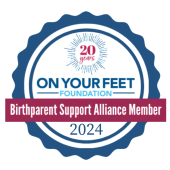Why Do We Practice Open Adoption?

Although adoption has existed for centuries, practices have changed significantly overtime. Legislation has been introduced to regulate adoption, ensure the safety of children, and protect the rights of birth and adoptive parents. Adoption practices have also shifted as we continuously reevaluate what is ethical and supportive for all people involved.
One of the biggest changes over the last several decades has been moving from closed to open adoption. Although open adoption is the norm now, for many decades it was common for no information to be shared with birth parents or adoptive families. There are many adoptees and birth parents from that era of adoption now searching for information or contact. Programs like the Illinois Adoption Registry and Medical Information Exchange and Confidential Intermediary services are provided by agencies like the Midwest Adoption Center, who can aid in this search. Unfortunately, since adoptees and birth families often have very little information to go off, searching can often take a long time.
The Challenges of Closed Adoption
We recently spoke with Judy, a birth mother who placed her newborn son for adoption 50 years ago. Judy was 21 years old when she made her adoption plan. At that time, adoption was very secretive. She did not know anything about the family that adopted her child or what happened to him after she placed. For decades, she carried her grief in private. Although she struggled with the loss and longed to know her child, she did not have anyone to share this experience with. The misguided stereotypes that birth mothers do not love their child or that they do not care only further perpetuate secrecy. Many fail to recognize that the decision to place a child for adoption comes from the birth parents overwhelming love for their child. Unfortunately, the negative perception of making an adoption plan means that many birth parents are shamed into keeping their feelings private. Because she never talked to anyone about her experience, Judy never realized that her feelings of love and longing for her child were completely normal.
While she grappled with her feelings in private, Judy always hoped she would find her son again. Unfortunately, for decades there were no resources available to help birth parents reconnect with their child. Judy was only left with the few details she knew from when she placed, like where she lived and what agency she placed through. At one point, she reached out to the agency to see if they could tell her anything. They were able to give her some general details on her son’s first few years of life, but unfortunately, the adoptive family had moved out of state and their communication ended after that, leaving the agency with no other information to share with Judy.
With the growth of the digital age, more options for searching became available. However, with little information on her son and the adoptive family, Judy did not have any luck finding him with online searches. A few years ago, Judy came across an online group for birth parents. One of the members suggested Judy try to connect with the Confidential Intermediary in her state. This service, provided to adoptees and birth families, assists with search and reunion. Within a few months of connecting with the Confidential Intermediary, Judy’s son was found. When the intermediary called Judy and told her that her son wanted to be in touch, it changed everything for her, like that missing piece had finally been found. Judy shared, “Placing my son for adoption was the hardest thing I have ever done. Finding him is the best thing that ever happened to me.” Since then, Judy and her son have texted, talked on the phone, and even Facetimed. They hope to meet in person soon.
Judy has also started to share her story with more people. All her life she never knew another person who had placed a child for adoption. She never talked to another birth mother and never knew if the grief she felt was normal. She wants other birth parents to know that what they are experiencing has been felt by others, and that there is support out there for them. Connecting with others who share a similar experience is crucial aspect of post adoption support, and one of the reasons we partner with organizations like On Your Feet Foundation, who offer a community of support for birth parents by birth parents.
As Judy has shared her story more, she has also reflected on how keeping this secret led her to be inauthentic in her relationships. She says, “It’s not just keeping things private or confidential. It’s creating a story about yourself that simply isn’t true. And so, you become an imposter in your own life.” Opening up about her experience has helped her recognize that being a birth parent is a fundamental part of her life story. Sharing that side of herself has liberated her, and for the first time, allowed her to exist as her authentic self.
The Benefits of Open Adoption
Many of the adoptees from the closed adoption era struggled with self-esteem and identity because so much of their story was kept from them. Many did not even know they were adopted until later in life. This secrecy of their history and where they came from left many with feelings of shame, confusion, and a muddled sense of who they are.
As we realized the harms of closed adoption, the concept of open adoption began to gain traction. Decades later, openness has become the norm for domestic adoptions over the last several decades. While closed adoptions still take place, most adoption agencies encourage openness and allow the birth parent to determine if they want to have contact following placement.
Continued contact gives the birth parent peace of mind. Not only do they get to see their child grow, but they get to witness them thrive in the family they chose for them. Seeing that their child is happy can be a comfort while navigating the grief that comes with placing a child for adoption. Although their role as a parent is different, they are still an important part of their child’s life.
Open adoption also allows the adoptee the opportunity to know where they come from. With closed adoptions, adoptees often only have the information that was shared when they were born. As we discussed in our recent blog with Eli, a 24 year-old adoptee who is learning about their birth family, adoptees may start to wonder more about their birth family as they grow up. Through open adoption, they’re able to connect with their birth parents and have access to that side of their story. This connection can also be healing because it allows them to know more about why they were placed, which is something many adoptees in closed adoptions struggle with.
Another benefits for both adoptees and adoptive parents is continued access to the child’s medical history. Birth family history is shared at the time of placement, but more health conditions may emerge later on in life. With ongoing contact through open adoption, the birth family can share these important updates.
The goal of open adoption is not only to have continued contact, but also create an atmosphere where everyone can openly talk about adoption. For the adoptee, this means always knowing where they come from and being able to talk about their adoption story. For the birth parent, this means having your experience and feelings validated. As we learned talking to Judy, closed adoption can force birth parents to keep their pain private. Open adoption encourages us to recognize the love that birth parents have for their child and how the difficult decision to place is for so many.
Of course, like all relationships, open adoption is not always perfect. There may be times when it’s difficult for the birth parent to see their child and not be parenting them. It may be hard for adoptive parents to reconcile the fact that their child shares a bond with their birth parent that they never will. Even adoptees may struggle at times seeing how different their life may have been if their birth parent had not chosen to place. Still for many, the benefits of continued contact and ongoing relationships with open adoption are worth it.
Why ACFB Supports Open Adoption
ACFB is an open adoption agency, which means all of our waiting adoptive families are prepared for openness. When an adoption match is made, we work with the expectant parents and prospective adoptive family to develop a plan for contact that works for everyone.
The core of our commitment to open adoption is that it has been shown to have the best outcomes for adoptees. One of our favorite books, The Open-Hearted Way to Open Adoption: Helping Your Child Grow Up Whole by Lori Holden, expertly sums up open adoption as giving the child “the opportunity to merge his or her biology with his or her biography.” With open adoption, they get the complete picture of where they come from, which helps them understand who they are.
While adoption can bring positive outcomes for everyone involved, it can also involve grief, loss, and pain. Open adoption offers a healing, healthy way for adoptees, birth parents, and adoptive families to manage those difficult feelings.





